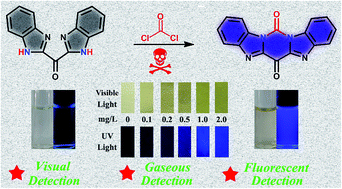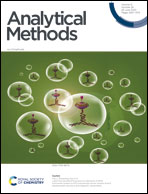Sensitive and selective detection of phosgene with a bis-(1H-benzimidazol-2-yl)-based turn-on fluorescent probe in the solution and gas phase†
Abstract
As one of the chemical weapons in World War I, phosgene (COCl2) is an extremely toxic gas. Due to wide applications in industrial production, phosgene can easily leak inadvertently and poses a serious threat to the environment and human health and safety. In this study, we report for the first time a new fluorescent probe (bis-(1H-benzimidazol-2-yl)-methanone) for the rapid detection of phosgene. The probe is based on the easily prepared bis-(1H-benzimidazol-2-yl), which can quickly combine with phosgene to obtain a six-membered cyclic carbamylation product showing fluorescence turn-on. The combination of phosgene caused the maximum absorption of the probe shifting from 361 nm to 373 nm, which showed a color change from colorless to yellow under visible light. Meanwhile, a strong fluorescence emission peak appeared at 428 nm, which showed change from no fluorescence to blue-violet fluorescence under a UV lamp (365 nm). The response of the probe towards phosgene is fast (within 30 s), highly selective and sensitive (the detection limit in solution being 3.3 nM). Furthermore, the portable test strips manufactured using the probe can conveniently perform visual and fluorescence detection of phosgene in the gas phase.



 Please wait while we load your content...
Please wait while we load your content...